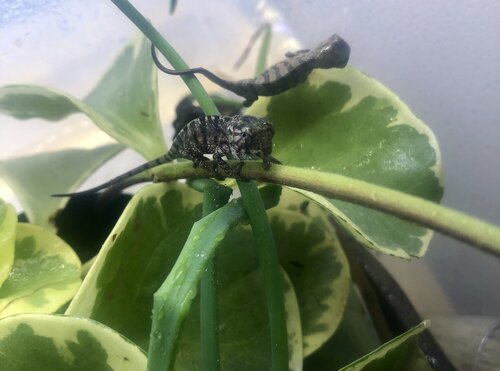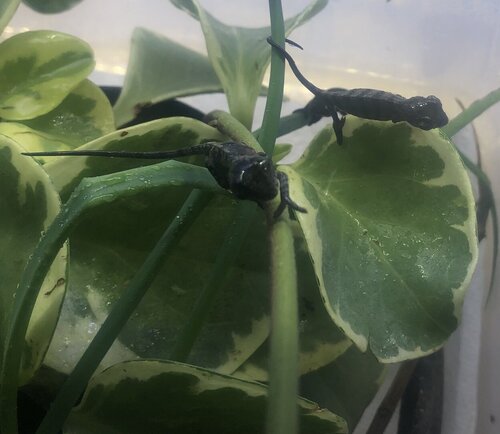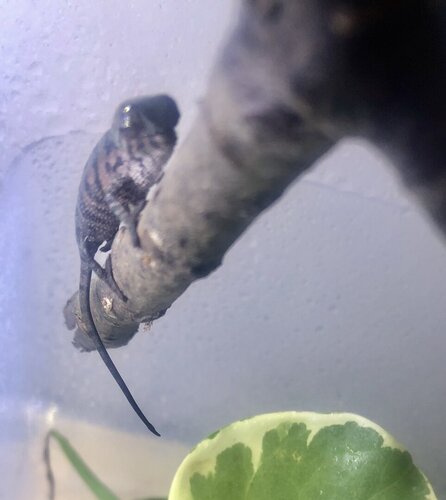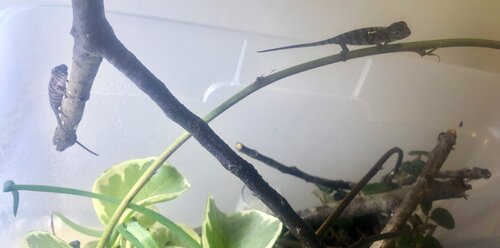Navigation
Install the app
How to install the app on iOS
Follow along with the video below to see how to install our site as a web app on your home screen.
Note: This feature may not be available in some browsers.
More options
You are using an out of date browser. It may not display this or other websites correctly.
You should upgrade or use an alternative browser.
You should upgrade or use an alternative browser.
After 11 months, panther babies hatched!!!
- Thread starter ldarmo
- Start date
They are adorable!Update: Since the four babies hatched 8/12 (three) and 8/19 (one), all continue to be active and alert. Mostly eating bean beetles and fruit flies. I'll post pictures later today or this week.
ldarmo
Avid Member
Here are a couple of quick pictures. I’ll try and get better ones later!
Attachments
Sketchie&Apollo
New Member
Congrats on your new babies!
ldarmo
Avid Member
Update: They are about a month old now and all four are still doing well!
Baby ambanja panther chameleons (hatched from eggs I bought from @Matt Vanilla Gorilla) are all still alive and well. Four of four eggs hatched after a long incubation. They recently graduated to eating small crickets, but still get bean beetles and flightless fruit flies. This is my first stab at hatching eggs and raising babies. So far, it seems to be going well. Here’s a quick picture of three of the four. I’ll try to include all four in the shot next time.

Baby ambanja panther chameleons (hatched from eggs I bought from @Matt Vanilla Gorilla) are all still alive and well. Four of four eggs hatched after a long incubation. They recently graduated to eating small crickets, but still get bean beetles and flightless fruit flies. This is my first stab at hatching eggs and raising babies. So far, it seems to be going well. Here’s a quick picture of three of the four. I’ll try to include all four in the shot next time.
Matt Vanilla Gorilla
Chameleon Enthusiast
So
Cool! So proud of you!Update: They are about a month old now and all four are still doing well!
Baby ambanja panther chameleons (hatched from eggs I bought from @Matt Vanilla Gorilla) are all still alive and well. Four of four eggs hatched after a long incubation. They recently graduated to eating small crickets, but still get bean beetles and flightless fruit flies. This is my first stab at hatching eggs and raising babies. So far, it seems to be going well. Here’s a quick picture of three of the four. I’ll try to include all four in the shot next time. View attachment 246268
Matt Vanilla Gorilla
Chameleon Enthusiast
Thank you too!!!My ambilobe hatchling is a spazz lol.. my family named it, thanks matt!!
ldarmo
Avid Member
@Matt Vanilla Gorilla do you know if/when the other eggs hatched? I'm wondering about incubations time for that clutch, and if my 11 months, 2 days was more or less than others? And what I did that may have affected incubation time. I'm just curious. Thank you for all the great support and advice.
Matt Vanilla Gorilla
Chameleon Enthusiast
Most of them took 9 to 11 months to hatch. Some locales take longer to incubate (Ambanja, Mitsio and a few others usually do. Humidity humidity fluctuations .mand incubation temperature also plays a role. I have often wondered if elevation above sea level plays a role but I have never seen any scholarly papers about it.
On a happy note, longer incubation times are also correlated with healthier hatchlings! Chammy mills (like puppy mills) try to pump babies out as fast as they can. They therefore use a higher incubation temperature and then suddenly increase the humidity on the eggs at round about 6 months of incubation. The eggs will then often hatch with in 2 to 3 weeks after this humidity change.
My average incubation time is 9 months.
On a happy note, longer incubation times are also correlated with healthier hatchlings! Chammy mills (like puppy mills) try to pump babies out as fast as they can. They therefore use a higher incubation temperature and then suddenly increase the humidity on the eggs at round about 6 months of incubation. The eggs will then often hatch with in 2 to 3 weeks after this humidity change.
My average incubation time is 9 months.
ldarmo
Avid Member
I'm very happy with my results, and was fine with waiting 11 months. The big bonus was that the fourth egg, which looked different from the others, and which I thought might be inviable, hatched a week later than the first three. Hopefully, all babies will continue to thrive. Thanks again, Matt.Most of them took 9 to 11 months to hatch. Some locales take longer to incubate (Ambanja, Mitsio and a few others usually do. Humidity humidity fluctuations .mand incubation temperature also plays a role. I have often wondered if elevation above sea level plays a role but I have never seen any scholarly papers about it.
On a happy note, longer incubation times are also correlated with healthier hatchlings! Chammy mills (like puppy mills) try to pump babies out as fast as they can. They therefore use a higher incubation temperature and then suddenly increase the humidity on the eggs at round about 6 months of incubation. The eggs will then often hatch with in 2 to 3 weeks after this humidity change.
My average incubation time is 9 months.
ldarmo
Avid Member
A few more pictures... (hatched 8/12-8/19)
The baby chameleons are getting bigger! First picture is the largest of the four. Next three are another one, for scale. Numbers three and four are sleeping in the foliage... (background for the last three pictures is a heavily planted aquarium on my desk at work).




The baby chameleons are getting bigger! First picture is the largest of the four. Next three are another one, for scale. Numbers three and four are sleeping in the foliage... (background for the last three pictures is a heavily planted aquarium on my desk at work).
They are precious! You said they are Matt's Ambanja babies right? I can never get it straight the adult coloring of the different locales. Especially the Ambanja and the Ambilobe. It certainly is crazy how tiny they start out. <3A few more pictures... (hatched 8/12-8/19)
The baby chameleons are getting bigger! First picture is the largest of the four. Next three are another one, for scale. Numbers three and four are sleeping in the foliage... (background for the last three pictures is a heavily planted aquarium on my desk at work).
View attachment 246842View attachment 246843View attachment 246844View attachment 246845
The Wild One
Chameleon Enthusiast
Sooooo pretty I wish they satiated that tiny
ldarmo
Avid Member
Thank you! It was a long wait (but worth it!) Maybe it was long because I didn’t use an incubator. I just kept them under my desk at work. I used a min-max thermometer/hygrometer, and temp and humidity seemed to stay within range. It is possible that even thought they were generally minor, fluctuations in temperature and humidity delayed them. But the hatch time seems within normal range. Do you have any thoughts about the 11 month hatch time?Congrats!
Long wait eh?
BTW I had an incubator all ready for the eggs when they arrived. I decided not to use it due to not wanting to risk it overheating.
The temperature they are incubated at affects the hatch time. The warmer the quicker the hatch some degree. (Temperature has to be in an acceptable range.)
Some people hatch them at a constant temperature and others use fluctuating temperatures. Mine were open to the room air but on a raised screen frame over a heating pad...but don't forget...I live in Canada and it gets quite cold here so I needed some kind of heat.
I'm not sure how much minor fluctuations will affect the hatch.
There was som info out there...ill see if I can find it again.
Was it dark under the desk?
Some people hatch them at a constant temperature and others use fluctuating temperatures. Mine were open to the room air but on a raised screen frame over a heating pad...but don't forget...I live in Canada and it gets quite cold here so I needed some kind of heat.
I'm not sure how much minor fluctuations will affect the hatch.
There was som info out there...ill see if I can find it again.
Was it dark under the desk?
ldarmo
Avid Member
Hi, thank you for the informative response! I am in North Carolina, my office is pretty well climate controlled, but occasionally it gets a bit warm. I didn't want to risk an incubator overheating. During incubation, temperatures stayed in the range of high 60s to mid-70s (rarely below 68 and rarely higher than 77). I didn't measure the frequency or duration of the fluctuations, just monitored minimum/maximum temperatures weekly. The lowest temperature I recorded was 65 (during the winter) and the highest was 80 (during the summer), but for the most part temperatures ranged from 68 to 77. It is not completely dark under my desk, but light is subdued during the day, and of course dark at night. In the future, I can place the box in a more uniformlty dark place. Having it under my desk helped remind me to check on the eggs frequently.The temperature they are incubated at affects the hatch time. The warmer the quicker the hatch some degree. (Temperature has to be in an acceptable range.)
Some people hatch them at a constant temperature and others use fluctuating temperatures. Mine were open to the room air but on a raised screen frame over a heating pad...but don't forget...I live in Canada and it gets quite cold here so I needed some kind of heat.
I'm not sure how much minor fluctuations will affect the hatch.
There was som info out there...ill see if I can find it again.
Was it dark under the desk?
Last edited:
krikinit
Chameleon Enthusiast
You can keep them together for about 3 months but keep an eye on their behavior. If one is bullying or posturing, separate them. Also if one is not growing as fast, separate. They may not be getting their fair share of food. I am currently raising 5 baby nosy faly and this is what i am looking for.
Similar threads
- Replies
- 5
- Views
- 3K









